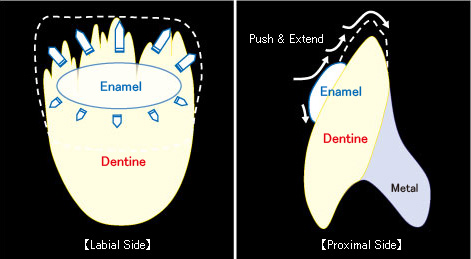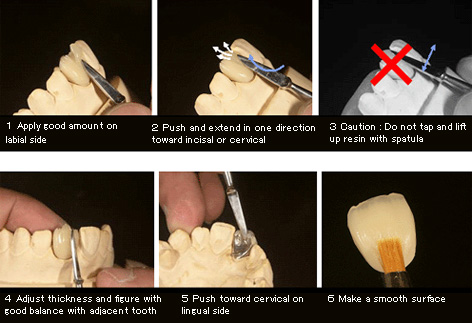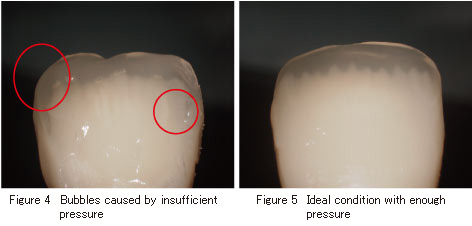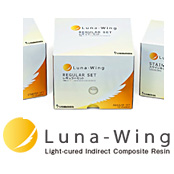
Q1.Where is the Base used?
Base is used for a pontic of connected teeth such as a bridge. * Base is exclusively designed for a pontic, so that cannot be used on facing area.
Q2.Is it possible to use body resin other than Base remaining in a bottle for a pontic?
Make sure to use a product with enough light cure depth as a pontic requires a thick build up.
Q3.How to use Opaque Dentine?
Opaque Dentine is used when the space for Dentine is not enough and Opaque color is strongly visible. e.g. 0.5mm of less for Dentine space : Thinly build Opaque Dentine (approx. 0.2mm) to reproduce a crown form, then build Dentine.
Partial use on a cervical area or incisal may be effective to cover Opaque color and a metal backing line.
Q4.What are the Red Plus Shades?
Red Plus Shades are designed to reproduce the reddishness of a natural tooth, often observed in eastern Asian region.
Q5.How to use Effect?
Effect is a series of characterizing body resin for external staining techniques.
There are 9 colors in its line up.
* Refer to the Luna Wing Instruction for details.
Q6.Enamel appears too white.
Enamel layer may be too thick. Try to increase a thickness of Dentine layer and make thinner Enamel layer.
If a thick Dentine layer causes unnaturally dark shade, use of highly transparent item such as Trans Enamel or Translucent is recommended.
Q7.Body resin seems to be too hard.
Resin materials include Opaque have a thixotropy property.
Providing an external force with a spatula will make paste soft. However, make sure not to fold up paste to avoid bubbles.
Handling of composite resin may vary depending on the temperature.
20 – 25℃ is recommended for a good handling. (leave in a 20℃ room for more than 20 minutes before use if stored in a low temperature)
*Thixotropy : Property to become soft by an external force, and stay in the stable form without an external force.
Q8.Bubbles are observed during build up.
1. Bubbles caused by repeated tapping during build up
Direct application from a syringe may cause small bubbles inside. Flatten a cut surface (roughness of a surface) with a spatula after cutting resin from a syringe.
Large bubbles tend to appear when building up Enamel over Dentine’s light cured surface.
When building up a new layer, push and extend resin towards one direction. Tapping with a spatula may cause bubbles between resin and light cured surface.

Diagram of Enamel build up

Procedure of Enamel build up
2. Bubbles caused by roughness of resin’s cut surface
Cut resin from a syringe may have a rough surface (figure 1), and directly building resin with a rough surface may cause small bubbles. Flatten the cut surface (figure 2, 3) before building up to prevent bubbles.
In addition, also flatten the surface when putting back excess resin into a syringe.

3. Bubbles caused by insufficient pressure
When covering mamelon structure, simply layering over with Enamel will not be enough force to cover detailed parts, and it sometimes causes bubbles (figure 4).
In order to prevent bubbles, give enough pressure to resin when covering mamelon structures with Enamel (figure 5).

Q9.Finished facing crown seems to be darker than the shade guide.
Dentine may be too thick ( >1mm). Possible solutions are following.
1. Enamel is recommended to be built 1/3 of the entire area from incisal. Making a slope which makes a thickness thinner towards cervical may work to adjust a shade.
2. Change the shade of Dentine.
e.g. Opaque OA3 + Dentine DA3 (appears dark) → Opaque OA3 + Dentine DA2
Q10.Crack found in a connector when light cured a bridge.
Crack problems occasionally happen when a large amount of resin is built up due to the light cure shrinkage. Dividing the build up procedure into multiple steps will prevent crack problems.
In case of using a light curing machine which generates heat (using infrared light), light cure shrinkage rate increases. Apply a cut to a connector, build up tooth by tooth, and add a little amount of resin to a connector at last to prevent a crack.
Q11.What are Luna-Wing’s handling characteristics?
Luna-Wing’s Enamel (Enamel, Trans Enamel, Translucent and Effect) are designed to be 30% softer than Dentine (Cervical, Opaque Dentine and Dentine).
1.Dentine resin has enough hardness to reproduce complicated shapes such as mamelon structures, and is also able to maintain those shapes.
2.By giving higher consistency to Enamel, it is easy to blend in to mamelon structures and other detailed spaces without bubbles.

YAMAKIN will respond to inquiries on the business day.
If we receive any inquiries during company holidays such as
Saturdays, Sundays, public holidays in Japan,
we will reply to you on the next day.
Business Hours: Weekday 8:45am to 17:45pm.